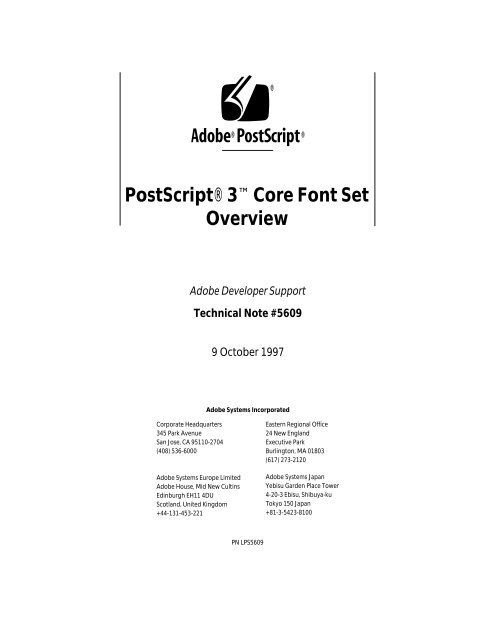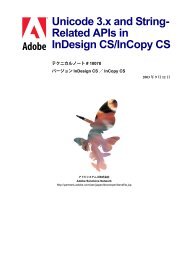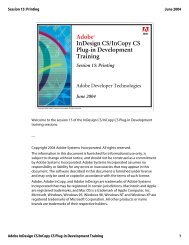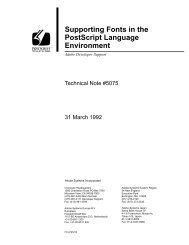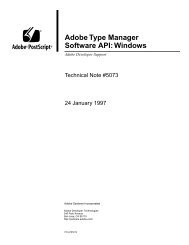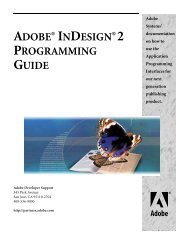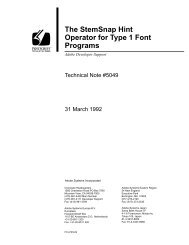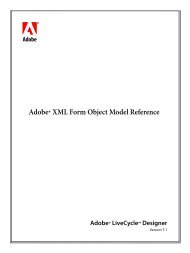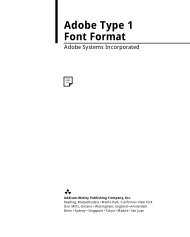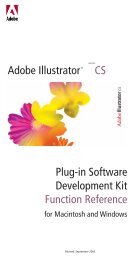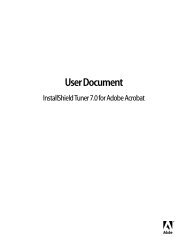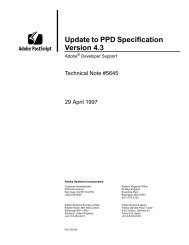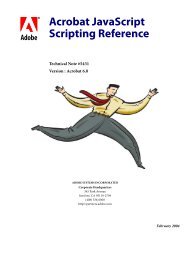PostScript 3 Core Font Set Overview - Adobe Partners
PostScript 3 Core Font Set Overview - Adobe Partners
PostScript 3 Core Font Set Overview - Adobe Partners
You also want an ePaper? Increase the reach of your titles
YUMPU automatically turns print PDFs into web optimized ePapers that Google loves.
®<br />
® ®<br />
<strong>PostScript</strong>® 3 <strong>Core</strong> <strong>Font</strong> <strong>Set</strong><br />
<strong>Overview</strong><br />
<strong>Adobe</strong> Developer Support<br />
Technical Note #5609<br />
9 October 1997<br />
<strong>Adobe</strong> Systems Incorporated<br />
Corporate Headquarters<br />
345 Park Avenue<br />
San Jose, CA 95110-2704<br />
(408) 536-6000<br />
<strong>Adobe</strong> Systems Europe Limited<br />
<strong>Adobe</strong> House, Mid New Cultins<br />
Edinburgh EH11 4DU<br />
Scotland, United Kingdom<br />
+44-131-453-221<br />
Eastern Regional Office<br />
24 New England<br />
Executive Park<br />
Burlington, MA 01803<br />
(617) 273-2120<br />
<strong>Adobe</strong> Systems Japan<br />
Yebisu Garden Place Tower<br />
4-20-3 Ebisu, Shibuya-ku<br />
Tokyo 150 Japan<br />
+81-3-5423-8100<br />
PN LPS5609
Copyright © 1997 <strong>Adobe</strong> Systems Incorporated. All rights reserved.<br />
NOTICE: All information contained herein is the property of <strong>Adobe</strong> Systems Incorporated.<br />
No part of this publication (whether in hardcopy or electronic form) may be reproduced or<br />
transmitted, in any form or by any means, electronic, mechanical, photocopying, recording, or<br />
otherwise, without the prior written consent of the publisher.<br />
<strong>PostScript</strong> is a registered trademark of <strong>Adobe</strong> Systems Incorporated. All instances of the name<br />
<strong>PostScript</strong> in the text are references to the <strong>PostScript</strong> language as defined by <strong>Adobe</strong> Systems<br />
Incorporated unless otherwise stated. The name <strong>PostScript</strong> also is used as a product trademark for<br />
<strong>Adobe</strong> Systems’ implementation of the <strong>PostScript</strong> language interpreter.<br />
<strong>Adobe</strong>, Acrobat, <strong>Adobe</strong>PS, <strong>Adobe</strong> Type Manager, ATM, Carta, Chameleon, and <strong>PostScript</strong>,<br />
<strong>PostScript</strong> 3, and the <strong>PostScript</strong> logo are trademarks of <strong>Adobe</strong> Systems Incorporated. Macintosh<br />
and TrueType are trademarks of Apple Computer, Inc., registered in the U.S. and other countries.<br />
Apple is a trademark of Apple Computer, Inc., registered in the U.S. and other countries, used<br />
under license. Hoefler Text Ornaments was designed by the Hoefler Type Foundry. HP is a<br />
registered trademark of Hewlett-Packard Company. Microsoft, Microsoft Office, and Windows,<br />
Windows NT, and Microsoft Wingdings are registered trademarks or trademarks of Microsoft<br />
Corporation. Coronet is a trademark of Ludlow Type Foundry. All other trademarks are the<br />
property of their respective owners.
1<br />
<strong>PostScript</strong> 3 <strong>Core</strong> <strong>Font</strong> <strong>Set</strong><br />
<strong>Overview</strong><br />
1 Introduction<br />
<strong>Adobe</strong> <strong>PostScript</strong>® 3 products introduce a number of enhancements to font<br />
handling for the <strong>PostScript</strong> language and to the core font set. This document<br />
discusses the new core font set of 136 fonts and the extension of the character set<br />
introduced to support the <strong>Adobe</strong> Central European (CE) character set. The<br />
changes to the <strong>PostScript</strong> language, a list of all core fonts, and a description of the<br />
new character sets and encodings are specified in the Supplement: <strong>PostScript</strong><br />
Language Reference Manual (LanguageLevel 3 Specification and <strong>Adobe</strong> <strong>PostScript</strong> 3<br />
Version 3010 Product Supplement).<br />
The changes to the <strong>PostScript</strong> language, core font set, and character sets offer the<br />
potential for improved printing performance, as well as other benefits for<br />
developers who wish to take advantage of the new features. The majority of the<br />
changes do not require developers to update existing software; a few changes offer<br />
the potential for extra benefits if the developer wishes to take advantage of them.<br />
Note: One change that may affect all applications that query the Windows® or<br />
Macintosh system for a list of fonts is that all fonts with CE character sets have either<br />
two FOND resources (for Macintosh), or two PFM files (for Windows). This means<br />
the application will get two font names returned for each font name that has a CE<br />
character set. For example, the Courier font will show up as both “Courier” and<br />
“CourierCE” in the list returned, as well as in the user’s font menu. These CE font<br />
names are listed in Appendix E of the Supplement: <strong>PostScript</strong> Language Reference<br />
Manual (LanguageLevel 3 Specification and <strong>Adobe</strong> <strong>PostScript</strong> 3 Version 3010<br />
Product Supplement).<br />
2 The <strong>PostScript</strong> 3 <strong>Core</strong> <strong>Font</strong> <strong>Set</strong><br />
The new core font set consists of 136 fonts:<br />
• the standard 35 fonts<br />
9 OCTOBER 1997
2 <strong>PostScript</strong> 3 <strong>Core</strong> <strong>Font</strong> <strong>Set</strong> <strong>Overview</strong><br />
• fonts to support the core fonts in Windows 95, Windows NT ® , and<br />
Macintosh<br />
• selected fonts from Microsoft ® Office and the HP 110 font set<br />
The remaining fonts in the core set were added to provide a well rounded variety<br />
of display and text fonts.<br />
The benefit of this larger core set is that printing performance will improve<br />
because frequently used fonts will not need to be downloaded to the printer.<br />
2.1 <strong>Core</strong> <strong>Font</strong> Formats: Addressing Multiple Markets<br />
<strong>Adobe</strong>’s strategy is to provide a wide range of fonts, and to make them available<br />
in several degrees of compactness. This allows <strong>Adobe</strong>’s printer OEMs to add value<br />
to their products in a manner that most suits the needs of their market. The<br />
differences in the font formats are transparent to the application or printer driver;<br />
all are selected and used in the normal manner.<br />
The highest quality fonts are needed for the graphic arts and publishing markets,<br />
which is where the Compact <strong>Font</strong> Format (CFF) will be used for printer-resident<br />
fonts. CFF offers a significant amount of font file size reduction (compared to<br />
Type 1 fonts), while retaining the highest quality of the best Type 1 fonts. The<br />
storage savings achieved by CFF fonts is not due to compression; rather it is a<br />
more efficient format, uses a more compact form of encoding commands and<br />
numbers, and<br />
For the office and enterprise markets, where price is a bigger issue than<br />
typographic quality, the <strong>Adobe</strong> Chameleon® technology is used to improve file<br />
compression for the majority of the core fonts. The core set of 136 fonts<br />
(including extended CE character sets) can be stored in a minimal amount of<br />
ROM, thus reducing costs. One side effect of this significant savings is that it is<br />
more difficult to achieve fidelity to the original typeface designs, and the hinting<br />
(information in the font that helps the quality of rendering at low resolutions) is<br />
not as effective (compared to equivalent Type 1 fonts) at lower resolutions. The<br />
host versions of the core fonts always use the original Type 1 or TrueType<br />
versions, so optimal quality is always provided for display on the screen.<br />
9 OCTOBER 1997
Section : The Chameleon <strong>Font</strong> Format<br />
3<br />
3 Host Support for <strong>Core</strong> <strong>Font</strong>s<br />
The 136 core fonts resident in printer ROMs will be provided by the printer<br />
vendor in either the Type 1 or TrueType font format. These fonts on the host are<br />
metrically compatible with the fonts in the printer, regardless of the format of the<br />
printer fonts. It is not expected that the Chameleon technology will be used for<br />
host fonts in the future.<br />
New releases of the <strong>Adobe</strong>PS printer driver (version 4.2 for Windows and<br />
version 8.6 for Macintosh) support the additional fonts and extended character<br />
sets.<br />
4 <strong>Core</strong> <strong>Font</strong> <strong>Set</strong> Formats<br />
<strong>PostScript</strong> 3 core fonts are represented in three different font formats, as<br />
explained in the following sections.<br />
The Chameleon <strong>Font</strong> Format<br />
The Chameleon font format is used to represent a large number of fonts in a small<br />
amount of storage space. The core set of Chameleon fonts consists of one Master<br />
<strong>Font</strong>, and a set of font descriptors that specify how the Master <strong>Font</strong> is to be<br />
adjusted to give the desired set of character shapes for a specific typeface.<br />
Because there is limit as to the complexity of shapes that can be represented in a<br />
single Master <strong>Font</strong>, the Chameleon format is used for only 112 of the 136 fonts.<br />
The format is undocumented; however Chameleon fonts are accessed in the usual<br />
way, as font resources, using the <strong>PostScript</strong> language. Chameleon fonts are used<br />
only in printer ROMs, where they are represented as Type 14 fonts. Type 1 and<br />
TrueType versions of the fonts will be used on host systems.<br />
CFF <strong>Font</strong>s<br />
CFF is similar to the Type 1 format, but it requires only about 50% to 60% of the<br />
storage space. While the space savings are not as great as with Chameleon fonts,<br />
the format is a totally lossless method for compactly representing fonts. It is not<br />
really a compression method, since no decompression is needed; CFF fonts are<br />
directly interpreted by the <strong>PostScript</strong> 3, which also aids performance. Type 1 fonts<br />
can be converted to CFF, and back again, and they will yield the exact same<br />
9 OCTOBER 1997
4 <strong>PostScript</strong> 3 <strong>Core</strong> <strong>Font</strong> <strong>Set</strong> <strong>Overview</strong><br />
bitmaps when rasterized by <strong>Adobe</strong> Type Manager ® (ATM ® ) software. The CFF<br />
specification is described in <strong>Adobe</strong> Technical Note #5176, The Compact <strong>Font</strong><br />
Format Specification.<br />
CFF is really a file structure format that uses a binary data structure to replace the<br />
<strong>PostScript</strong> font dictionary of a Type 1 font. This data structure may contain<br />
character descriptions (charstrings) of various formats, but it was designed to<br />
work best with Type 2 charstrings (see <strong>Adobe</strong> Technical Note #5177, The Type 2<br />
Charstring Format, for more information). This format is also used for font<br />
embedding for <strong>Adobe</strong> Acrobat® 3.0 products, and it will be the basis for the<br />
Type 1 versions of the new OpenType font format.<br />
CFF fonts achieve their compactness through the use of extended functionality<br />
operators, more efficient encoding of commands and numbers, the use of default<br />
values for many font entries, and the ability to share elements and subroutines<br />
across font families. <strong>Font</strong>s can be grouped into a <strong>Font</strong><strong>Set</strong>, which becomes a<br />
<strong>PostScript</strong> language font resource. The fonts contained in all Chameleon and CFF<br />
<strong>Font</strong><strong>Set</strong> resources also appear as instances of the <strong>Font</strong> resource category, which<br />
makes them individually accessible via the normal LanguageLevel 2 font resource<br />
operators, such as findfont, findresource, and resourceforall.<br />
TrueType/Type 42<br />
A number of fonts in the core font set are TrueType fonts, which were included<br />
because they are commonly used in Windows or Macintosh systems. Because<br />
fonts are provided in the printer, the user will experience increased performance<br />
and ease of use when printing to <strong>PostScript</strong> printers.<br />
A Type 42 font consists of a TrueType font with a <strong>PostScript</strong> language wrapper<br />
(that is, a font dictionary). The Type 42 format is specified in <strong>Adobe</strong> Technical<br />
Note #5012, The Type 42 <strong>Font</strong> Format Specification.<br />
TrueType fonts are represented in two formats: on the host they are in TrueType<br />
format, and in printers they are represented as CFF or Chameleon fonts,<br />
depending on the printer and intended market.<br />
9 OCTOBER 1997
Section : TrueType/Type 42<br />
5<br />
Table 1 shows a typical font configuration for a printer targeted for the office<br />
market. <strong>Font</strong>s that are typically in TrueType format on the host, such as those<br />
supplied with Windows and Macintosh systems, are represented in the printer as<br />
either CFF or Chameleon fonts. In a printer targeted for the graphic arts market,<br />
those same fonts would be represented in both the printer as Type 42 fonts (a<br />
TrueType font with a <strong>PostScript</strong> wrapper), and as a TrueType font on the host.<br />
TABLE 1 Potential <strong>Font</strong> Configuration for Office Market Printers<br />
LOCATION FONT FORMAT NUMBER OF FONTS<br />
Printer: CFF 24<br />
Chameleon 112<br />
Host: Type 1 117<br />
TrueType 19<br />
Table 2 shows a typical font configuration of the printer and host font formats for<br />
a graphic arts market printer, where users are more sensitive to typographic<br />
quality than to ROM size and cost. All fonts in the printer are likely to be in the<br />
CFF/Type 2 format to provide the hiqhest quality.<br />
TABLE 2 Potential <strong>Font</strong> Configuration for Graphic Arts Market Printers<br />
LOCATION FONT FORMAT NUMBER OF FONTS<br />
Printer: CFF 117<br />
TrueType 19<br />
Host: Type 1 117<br />
TrueType 19<br />
9 OCTOBER 1997
6 <strong>PostScript</strong> 3 <strong>Core</strong> <strong>Font</strong> <strong>Set</strong> <strong>Overview</strong><br />
<strong>Core</strong> <strong>Font</strong> Character <strong>Set</strong>s<br />
Of the 136 fonts in the core font set, 112 (that is, those in the Chameleon format)<br />
have the CE character sets and encodings. For the first release of host fonts, only<br />
55 of the Type 1 and TrueType fonts will have CE character sets.<br />
This CE character set adds support for a number of additional languages,<br />
including Baltic, Turkish, Czech, Hungarian, and Polish. The CE character set<br />
totals 253 characters; the union of this set with the standard character set yields a<br />
total of 315 characters. Currently, those characters are only accessible by users on<br />
a Macintosh GX system, or in Windows with a localized language version of the<br />
system.<br />
Table 3 shows the breakdown of character sets and font formats for the core font<br />
set for use on the host. <strong>Font</strong>s that have a character set of 315 glyphs are those that<br />
support the CE character set.<br />
TABLE 3 <strong>Core</strong> <strong>Font</strong> Character <strong>Set</strong>s for use on Host Computer<br />
FONT TYPE NUMBER OF FONTS CHARACTER SET<br />
Type 1 (symbol)<br />
3 (Carta®, Symbol, Zapf<br />
Dingbats)<br />
< unique ><br />
Type 1 (text) 112 229<br />
Type 1 (text)<br />
TrueType (symbol)<br />
2 (Apple Chancery,<br />
Coronet)<br />
2 (Microsoft Wingdings®,<br />
Apple Hoefler Text<br />
Ornaments)<br />
315<br />
< unique ><br />
TrueType (text) 17 315<br />
The character sets and encodings for the new fonts are shown in Appendix E of<br />
the Supplement: <strong>PostScript</strong> Language Reference Manual. That appendix also shows<br />
the new character added to the Symbol font, the European currency symbol,<br />
which is encoded at position 240 (decimal) in the font’s encoding vector.<br />
9 OCTOBER 1997


